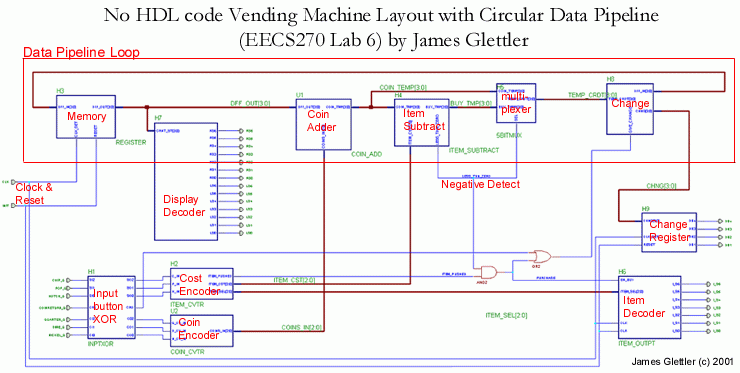EECS 270: Introduction to Logic Design
Completed: A
Binary and non-binary systems, Boolean algebra digital design techniques, logic gates, logic minimization, standard combinational circuits, sequential circuits, flip-fl ops, synthesis of synchronous sequential circuits, PLAs, ROMs, RAMs, arithmetic circuits, computer-aided design. Laboratory includes hard-ware design and CAD experiments using logic schematic editors and ABEL hardware language.
Spring 2001, Professor W. Becher, Lab GSI Joe Collins
This was a pretty easy class overall. I had taken most of the material previously at KC/TC. However, what made the class awesome was the lab which was based of a Xilinx FPGA evaluation board and software. I wish that at least one lab would be with 74xx series TTL logic chips, but it was ok. The sixth and seventh projects were to be done entirely using ABEL code due to the apparent complexity involved. The sixth project was a vending machine controller and the seventh project was a small 16 opcode microcomputer. Project six was the most fun because I chose to redo it using only pure gates instead of ABEL. My ABEL implementation utilized 45% of the CLBs on the FPGA which was the lowest utilization out of the class. However, after reworking the entire project in pure logic gates using a custom data path, I was able to drop the utilization first to 16% and then finally to 6%. The longer data path however resulted in a slight (3MHz) decrease in maximum clock frequency down to 26.6MHz. A top level schematic of the non-code binary implementation of lab six is shown below:
Quotes:
- Student: "Is the class curved?" Professor: "It better be, or were all cooked!"
Notice:
Information provided on this page is a result of undergraduate studies at the University of Michigan. Material may be copyrighted by the University of Michigan, James Glettler, and/or the various co-authors noted in group projects. Finished assignments are offered only for reference.
